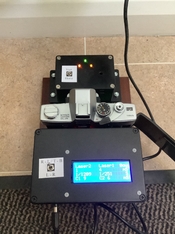UPDATE UPDATE UPDATE
A new version of the shutter tester for Arduino NANO is ready

)
Ver 3_1_1
*** I would still suggest that new builds are done using the ESP32 (PM me for the code)
as there is far more functionality ***
For the Arduino version, which most people have built, the changes are:-
1) Milliseconds are now displayed to one decimal place, rather than a rounded integer.
(This removes the rounding that could display 552uS and 1mS, as shown on post #355)
2) Seconds are now displayed to two or three decimal places, rather than a rounded integer.
3) Curtain travel time is now displayed to one decimal place.
4) Laser alignment utility is now included. (Yay)
How use Laser alignment utility:-
The optional buttons, as detailed in post #150 must be added.
When first powering up, wait for the splash screen to display. Then press & hold the 'Display Average' button (wired to pin 12)
This jumps to the Laser alignment utility. Now release the button.
When the laser shines onto the receiver '**seen**' will be displayed on the LCD. If the receiver is not seeing the laser, 'blocked' will be displayed.
Each laser is shown independently.
There are two versions of the receivers (just to complicate things). This is why there are two versions of the code 'ori' (original) and 'new'
Receivers recently purchased are likely to be the 'new' type, so if you are not sure of what receivers you have, try using the 'new' code first.
If your lasers seem to be working backwards (when Laser is shining on the receiver, LCD says 'blocked') then you should try the over version of the code.
Due to absolutely no memory left, the only way to exit the laser alignment check, is to re-boot the tester.
Similarly, although I tried to include a software solution for the new & original laser receiver types in one build, it is not possible
due to memory space within the Arduino Nano. In the ESP32 version, this has been incorporated, as well as other functionality & for new builds or upgrades, I would suggest using an ESP32 board.
*** I would still suggest that new builds are done using the ESP32 (PM me for the code) as there is far more functionality ***
Code will now be stored on github. link below.
The code will now be a hex file. All fully assembled, making it simpler, as no additional libraries need to be added to Arduino IDE program.
Arduino IDE is still used for output to the computer screen.
To load onto your Arduino, first follow the link to the github site.
Arduino / ESP32 based shutter tester using three lasers. This allows for correct focal plane curtain speed adjustment & even exposure across the frame. - billbill100/Camera-Shutter-tester-Cheap...

github.com
click on the green <>Code button, which will allow you to download all of the files as a zip file.
Un-zip the downloaded file. You will find two versions of Arduino code. 'ori' for the older original laser receivers and 'new' for the newer type.
(note:- there will also be an ESP32 version of the code, do not try loading this into an Arduino!).
To load the code onto the Arduino, you will need to download AVRDUDESS
follow the youtube video, from 2.30 to 5.15. Saravanan explains this, far better than I, how to use AVRDUDESS to load the code onto the Arduino.
github is a work in progress, so will be adding hardware build guides, general operation guides, loading software guides etc in the future.
Hope it is ok to take the build photos from Photrio & put them in the guides?
As always, appreciate a comment and photo of your finished shutter testers

)












 )
)


